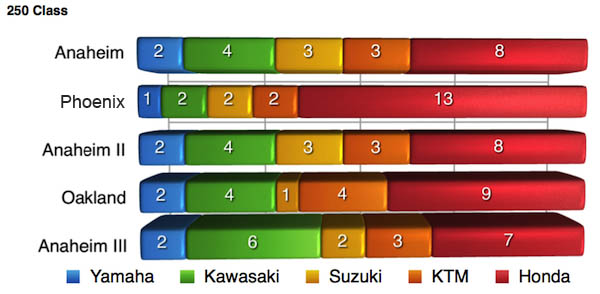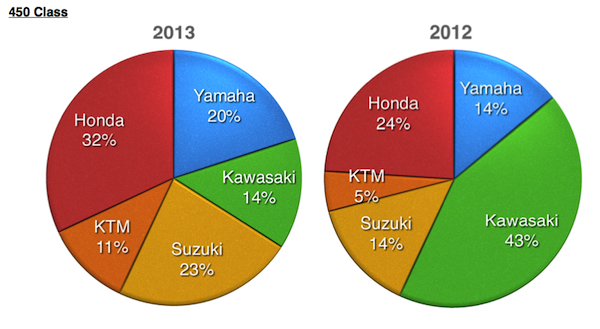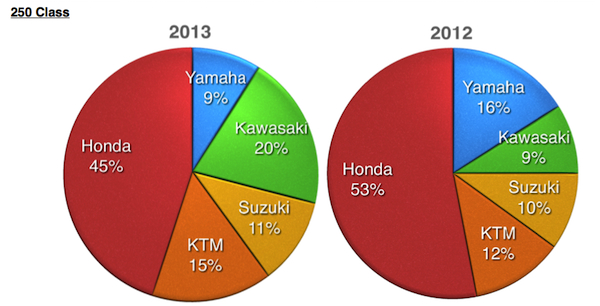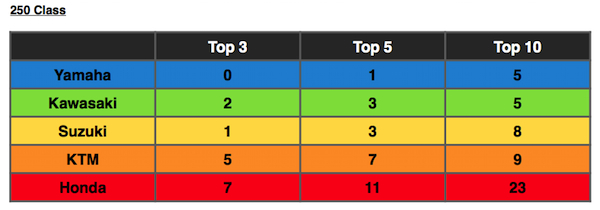In this weeks edition of Moto By Numbers, we will dive into the five main events that have taken place so far this year and look at how much real estate the different manufacturers have taken up in each.
In this weeks edition of Moto By Numbers, we will dive into the five main events that have taken place so far this year and look at how much real estate the different manufacturers have taken up in each.
By: Paul Quesnel
While I was watching the Los Angeles supercross with my niece last year, I distinctly remember her turning to me and asking, “why are there so many green bikes out there? Are they the best bike to race?” Now in this particular main event, there were exactly ten Kawasaki’s out on the track. Although Chad Reed was winning the race while aboard a Honda, the thing that really caught her attention was the green wave coming down the start straight. Since that night I have really started paying more attention to how many bikes each manufacturer is getting into the main event. The way I see it, every main event is like a billboard that the five different motorcycle brands in our sport have to share. When a certain brand gets ten bikes into the main, they get 50% of the billboard. On the other hand, when a brand only gets one bike into the main, then they are getting 5% of the billboard. Now although there is an argument to be made about how a manufacturer would rather get a bike on the podium instead of having three bikes outside the top ten, people still pay attention when they see ten green bikes out on the track and only one orange bike. In this weeks edition of Moto By Numbers, we will dive into the five main events that have taken place so far this year and look at how much real estate the different manufacturers have taken up in each.
The two charts below represent the 450 and 250 class. Each shows exactly how many bikes each motorcycle brand has gotten into every main event so far this year.
 |
•During the first five races of the 2012 season, Kawasaki had a total of 43 bikes in the main events. This year they have only had 14.
•Compared to 2012, KTM and Honda are the only manufacturers to have increased the number of their bikes in every main event.
•During the beginning of the 2011 season, Honda only had a total of 17 bikes in the first five main events. So far this year they have almost doubled that number with 32 bikes in the mains.
 |
•While the figures from Honda seem quite impressive, almost all of their numbers are down when you compare them to 2012.
•Although it may be hard to believe, the manufacturer that has made the biggest step up here is Kawasaki. At this time last year they had only put 9 bikes into the main events; right now they are up to 20.
•Aside from Honda, the only other brand that has seen its numbers go down from last year is Yamaha. At this time they have only gotten 9 bikes into the main event; last year they were already at 16.
The following pie charts represent both the 450 and 250 class. They show what percentage of total main event spots each manufacturer is responsible for through the first five rounds of 2013 & 2012.
 |
•As you can see, a big change has taken place in the 450 class between this year and last. While Kawasaki ruled the class in 2012, they continue to loose there foothold as the 2013 season keeps rolling.
•Technically, the biggest jump up out of any manufacturer has been Suzuki as they have added an additional 9% to their main event percentage in between seasons.
•Last year at this time, the gap between the brand that had gotten the most bikes into the main events and the brand with the least was 38%; the gap so far this year is only 21%.
 |
•A lot like Kawasaki in the 450 class, Honda pretty much ruled the 250’s with an iron fist in 2012. Not only did they eventually end up winning both titles, but they owned nearly half the spots in the main events for most of the series.
•So far this season, Honda has averaged 9 riders per 250 main event while Kawasaki has averaged 4; KTM has averaged 3; and both Suzuki and Yamaha have nearly both averaged exactly 2.
•Much like in the big bike class, KTM’s share of the main events has continued to grow from 2012 into current series.
The two charts below show how many bikes each manufacturer have gotten into each separate category throughout the first five races of the year.
 |
•So far this season, Honda has owned 33% of the top 3 spots, 40% of the top 5, and 38% of the top 10 available positions.
•As you can see, Yamaha has yet to stake there claim inside the top five so far this season. If I had to guess, I would say this has to be the first time in decades that its taken Yamaha this long to get a top five.
•At this point in the series last year, Suzuki had no top 3 results, only one top 5, and a total of 6 top ten finishes.
 |
•So far the mighty Pro Circuit squad has only been able to get 2 of the available 15 podium positions and 3 of the available 25 top 5 places.
•During the first five main events of 2013, Honda has nearly taken half of the available top 10 finishes. They have also taken 47% of the available top 3 spots and 44% of the available top five places.
•Just like in the the 450 class, the 250 Suzuki team had no top 3 finishes, only one top 5, and six top 10 finishes at this point last season.





